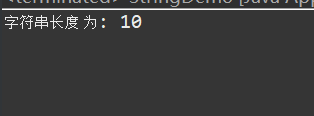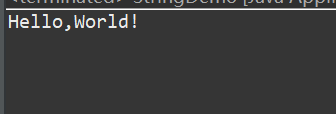一 . Java String 类
- 在 Java 中字符串属于对象,Java 提供了 String 类来创建和操作字符串.
- 创建字符串最简单的方式如下:
String sting = "hello";
- 注意 : String 类是不可改变的,所以你一旦创建了 String 对象,那它的值就无法改变了.
二 . Java String 类常用方法
- Java length() 方法:
语法
public int length()
返回值
返回字符串长度。
public class StringDemo {
public static void main(String args[]) {
String string = "helloword";
int l = string.length();
System.out.println( "字符串长度为 : " + l );
}
}
编译结果为:

- 连接字符串
String 类提供了连接两个字符串的方法 , 比较常用的是使用’+'操作符来连接字符串,例如:
public class StringDemo {
public static void main(String args[]) {
String string = "Hello";
System.out.println(string+","+ "World!");
}
}
编译结果如下:

- Java charAt() 方法
charAt() 方法用于返回指定索引处的字符。索引范围为从 0 到 length() - 1。
语法:
public char charAt(int index)
参数
index -------->字符的索引。
返回值
返回指定索引处的字符。
实例:
public class Test {
public static void main(String args[]) {
String string= "Hello,World";
char result = string.charAt(8);
System.out.println(result);
}
}
结果:

即字符串的"Hello,World"索引8位置的字符为"r".
- Java compareTo() 方法:
compareTo() 方法用于两种方式的比较:
a) 字符串与对象进行比较。
b) 按字典顺序比较两个字符串。
语法
int compareTo(Object o)
或
int compareTo(String anotherString)
参数
a) o -------- 要比较的对象。
b) anotherString -------- 要比较的字符串。
实例:
public class Test {
public static void main(String args[]) {
String str1 = "123456";
String str2 = "123456a";
String str3 = "123456abc";
int result = str1.compareTo( str2 );
System.out.println(result);
result = str2.compareTo( str3 );
System.out.println(result);
result = str3.compareTo( str1 );
System.out.println(result);
}
}
结果:

注意:
compareTo(String)方法中其实是从头开始,一个一个字符的比对原字符串和参数字符串中的字符,如果相同就下一个,直到字符出现不同(包括某一个字符串结束了)就计算这两个不同字符的ASCII码的差,作为返回值. 直到最后都相同就返回0.
- Java equals() 方法:
equals() 方法用于将字符串与指定的对象比较。
语法:
public boolean equals(Object anObject)
参数:
anObject ---------与字符串进行比较的对象。
返回值
如果给定对象与字符串相等,则返回 true;否则返回 false。
实例:
public class Test {
public static void main(String args[]) {
String Str1 = new String("hello");
String Str2 = Str1;
String Str3 = new String("hello");
boolean i;
i = Str1.equals( Str2 );
System.out.println("返回值 = " + i );
i = Str1.equals( Str3 );
System.out.println("返回值 = " + i );
}
}
结果:

- Java copyValueOf() 方法:
copyValueOf() 方法有两种形式:
a) public static String copyValueOf(char[] data): 返回指定数组中表示该字符序列的字符串。
b) public static String copyValueOf(char[] data, int offset, int count): 返回指定数组中表示该字符序列的 字符串。
语法
public static String copyValueOf(char[] data)
或
public static String copyValueOf(char[] data, int offset, int count)
参数
data – 字符数组。
offset – 子数组的初始偏移量。
count – 子数组的长度。
返回值
返回指定数组中表示该字符序列的字符串。
实例:
public class Test {
public static void main(String args[]) {
char[] Str1 = {'h', 'e', 'l', 'l', 'o', ' ', 'w', 'o', 'r', 'l', 'd'};
String Str2 = "";
Str2 = Str2.copyValueOf( Str1 );
System.out.println("返回结果:" + Str2);
Str2 = Str2.copyValueOf( Str1, 2, 6 );
System.out.println("返回结果:" + Str2);
}
}
结果:

- Java indexOf() 方法:
indexOf() 方法有以下四种形式:
a)public int indexOf(int ch): 返回指定字符在字符串中第一次出现处的索引,如果此字符串中没有这样的字符,则返回 -1。
b)public int indexOf(int ch, int fromIndex): 返回从 fromIndex 位置开始查找指定字符在字符串中第一次出现处的索引,如果此字符串中没有这样的字符,则返回 -1。
c)int indexOf(String str): 返回指定字符在字符串中第一次出现处的索引,如果此字符串中没有这样的字符,则返回 -1。
d)int indexOf(String str, int fromIndex): 返回从 fromIndex 位置开始查找指定字符在字符串中第一次出现处的索引,如果此字符串中没有这样的字符,则返回 -1。
语法
public int indexOf(int ch )
或
public int indexOf(int ch, int fromIndex)
或
int indexOf(String str)
或
int indexOf(String str, int fromIndex)
参数
ch – 字符,Unicode 编码。
fromIndex – 开始搜索的索引位置,第一个字符是 0 ,第二个是 1 ,以此类推。
str – 要搜索的子字符串。
返回值
查找字符串,或字符 Unicode 编码在字符串出现的位置:
实例:
public class Main {
public static void main(String args[]) {
String string = "aaa456ac";
//查找指定字符是在字符串中的下标。在则返回所在字符串下标;不在则返回-1.
System.out.println(string.indexOf("b")); // indexOf(String str); 返回结果:-1,"b"不存在
// 从第四个字符位置开始往后继续查找,包含当前位置
System.out.println(string.indexOf("a",3));
//indexOf(String str, int fromIndex); 返回结果:6
//(与之前的差别:上面的参数是 String 类型,下面的参数是 int 类型)参考数据:a-97,b-98,c-99
// 从头开始查找是否存在指定的字符
System.out.println(string.indexOf(99));
//indexOf(int ch);返回结果:7
System.out.println(string.indexOf('c'));
//indexOf(int ch);返回结果:7
System.out.println(string.indexOf(97,3));//indexOf(int ch, int fromIndex); 返回结果:6
System.out.println(string.indexOf('a',3));//indexOf(int ch, int fromIndex); 返回结果:6
}
}
结果:

- Java replace() 方法
replace() 方法通过用 newChar 字符替换字符串中出现的所有 oldChar 字符,并返回替换后的新字符串。
语法
public String replace(char oldChar, char newChar)
参数
oldChar – 原字符。
newChar – 新字符。
返回值
替换后生成的新字符串。
实例:
public class Test {
public static void main(String args[]) {
String Str = new String("hello");
System.out.print("结果 :" );
System.out.println(Str.replace('o', 'T'));
System.out.print("结果:" );
System.out.println(Str.replace('l', 'D'));
}
}
结果:

